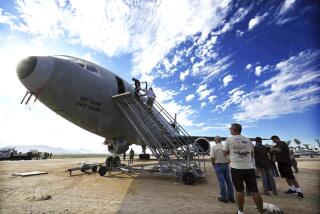Daring Raid Rescues U.S. Pilot in Iraq
- Share via
DHAHRAN, Saudi Arabia — Two U.S. Air Force pilots Monday launched a daring, eight-hour mission into Iraq, locating a downed Navy pilot in the desert and directing his successful rescue, military authorities said.
The operation, conducted as the drawn, frightened images of captured U.S. pilots in Iraq flickered on television sets all over the world, began about 8 a.m. and concluded when the pilot was found at midafternoon in a featureless stretch of the Iraqi desert.
A helicopter swept down to pick up the pilot, who was not injured, just as a large Iraqi truck drove into the area and appeared headed for the rescue site, authorities said.
The pilot “is rather pleased to be where he is tonight,” said Capt. Paul Johnson, one of the A-10 Thunderbolt pilots who led the tense search-and-rescue effort, deep within hostile territory.
“It was a rather indescribable feeling to know that he was now on the helicopter, and we were coming out of enemy territory--that we were about to pull this off,” Johnson added.
Air Force officials would not release any details about the pilot, his aircraft, or precisely where in Iraq he ejected after his plane was hit with groundfire. They also would not disclose how long he had to wait for his rescuers, but observers speculated he may have been down in the desert since Friday.
The downed plane was an A-6 Intruder, and the Navy had earlier listed two such craft as missing Friday. The Intruder is a carrier-launched attack plane that carries a crew of two. There was no word here on any second crewman.
Back at squadron headquarters, elated pilots celebrated the operation after several frustrating days of being grounded by bad weather.
“It’s really galvanized us,” said Wing Commander Ervin C. Sharpe of the 354th Tactical Fighter Wing. “Especially because of that,” he added, pointing to a television news program depicting pilots imprisoned in Iraq.
The images of the pilots, some of them appearing bruised, most appearing to be speaking under duress, have had an unsettling effect on American fliers all over the Persian Gulf.
“It puts a jab in your gut,” said Capt. Pete Edgar, a fighter pilot based now in eastern Saudi Arabia. “It doesn’t make you feel that great about what is going on up there, but I would hope he (Iraqi President Saddam Hussein) would treat them under the Geneva Convention.”
Capt. Mike Dowd, a Thunderbolt pilot, said his first thought was: “My God, this poor guy has been traumatized and has been beaten. And that could happen to me.”
But most pilots said the haunting images are not likely to dampen their determination to settle the conflict with Iraq decisively.
“We will hit them harder, and make him pay for every violation of decency,” declared Maj. Scott Hill, a fighter pilot. “But when we go to war, we go to war smart. We don’t go with our hair on fire and our fangs out.”
In Monday’s rescue operation, Johnson and Capt. Randy Goff, pilot of a second A-10, had been assigned to routine search-and-rescue duty, a variant from the A-10 squadrons’ usual armor-destroying duty, when the call for help came.
The two pilots quickly lifted into the air and headed north toward Iraq. During two hours en route to the Iraqi desert, “we built our plan,” Johnson said.
The Navy pilot, who had parachuted into a large expanse of desert, was equipped with flares, smoke grenades and a small radio to help him communicate with potential rescuers, Air Force spokesmen said.
However, it wasn’t until midday that the two A-10 pilots, talking with the downed flier by radio, moved into the region in which he was believed to be located.
Quickly, they radioed for a rescue helicopter to move in with them. They were aiming, Johnson said, “to get all the key players in place,” and then to “go in and pick up the survivor with minimum risk.”
For some time, the two A-10s circled over the area in which they believed the downed pilot to be, never actually seeing him as they talked with him on the radio and waited for the helicopter to arrive.
“Basically, my heart was pumping pretty quickly,” Goff said. “It is really exciting, the fact that you think the guy is going to get rescued. My mind was just rescued.”
The helicopter had no sooner arrived when the Iraqi truck rolled up.
“We couldn’t afford to have him there,” Johnson said simply.
As the truck came within 200 yards of the downed pilot, the two A-10s moved in with their tank-killing weapons, firing armor-piercing bullets from their 30-millimeter Gatling guns.
The truck burst into flames, and the pilot made a dash for the helicopter.
Still ahead was the grueling trip back to Saudi Arabia, which required an aerial refueling.
“The adrenaline was pumping for two hours after the pickup,” Johnson said. “It’s still pumping now.”
This story was compiled from combat pool dispatches reviewed by a military censor.
More to Read
Sign up for Essential California
The most important California stories and recommendations in your inbox every morning.
You may occasionally receive promotional content from the Los Angeles Times.













